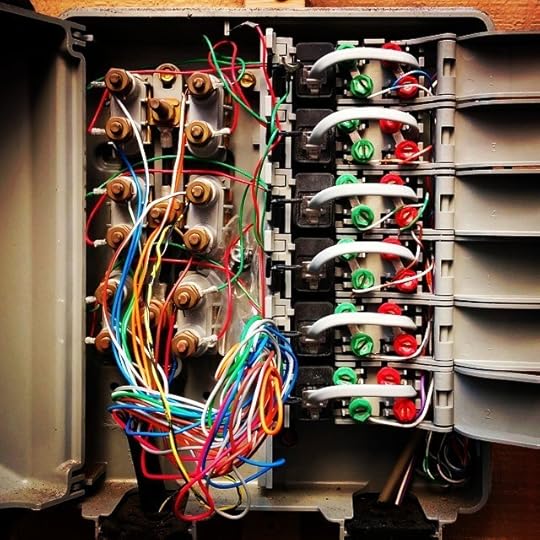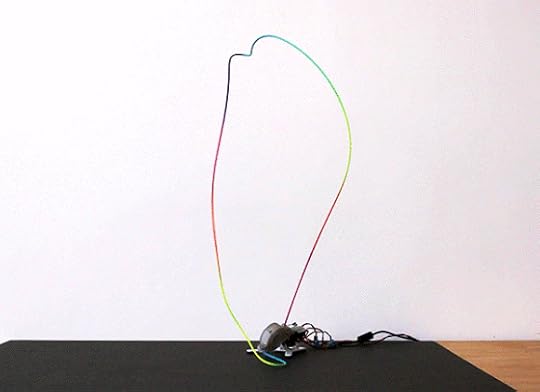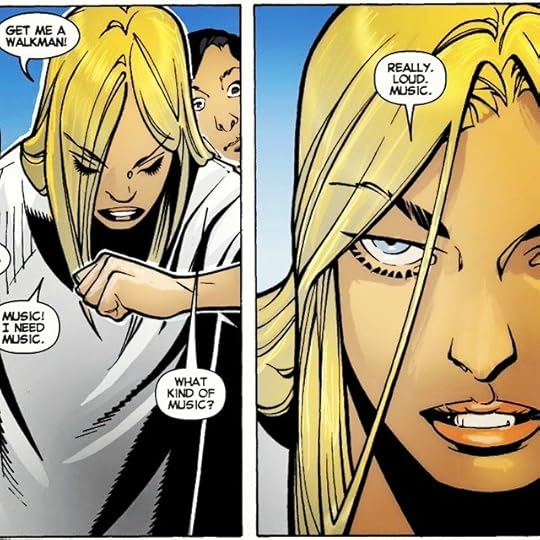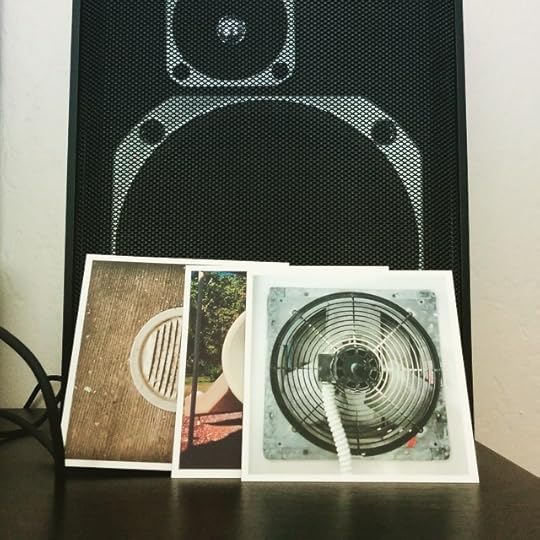Marc Weidenbaum's Blog, page 393
January 22, 2015
Disquiet Junto Project 0160: One Minute Past Midnight

Each Thursday in the Disquiet Junto group on SoundCloud.com and at Disquiet.com, a new compositional challenge is set before the group’s members, who then have just over four days to upload a track in response to the assignment. Membership in the Junto is open: just join and participate.
This assignment was made in the early evening, California time, on Thursday, January 22, 2015, with a deadline of 11:59pm wherever you are on Monday, January 26, 2015. (This week there is a little wiggle room. See below.)
These are the instructions that went out to the group’s email list (at tinyletter.com/disquiet-junto):
Disquiet Junto Project 0160: One Minute Past Midnight
The Assignment: Make a one-minute field recording starting right at midnight (wherever you are).
This week’s project is very simple. It asks that you make a field recording of sound, just one single minute, starting at a specific time: midnight.
From simple things complex things sometimes grow, and this project is a hopeful initial step toward a variety of related projects that may spring up over the course of 2015, perhaps even culminating in some sort of collection, maybe even in a physical space along the lines of the “Sonic Frame” installation at the San Jose Museum of Art (that piece largely drew its sonic material from an earlier Junto project). No one’s work will be repurposed without their permission, and it’s appreciated if you post your track with a Creative Commons license that allows for non-commercial reuse and sharing.
The steps are as follows:
Step 1: Record audio, outdoors or indoors, at midnight wherever you are.
Step 2: You can post the audio as is, or create a slight fade in of volume at the start and fade out at the end.
Step 3: Upload the finished track to the Disquiet Junto group on SoundCloud. Please consider posting photography, even video, associated with your efforts.
Step 4: Then listen to and comment on tracks uploaded by your fellow Disquiet Junto participants.
Deadline: Projects are usually due at 11:59pm wherever you are on Monday, January 26, 2015. This time, if you need to do the recording the final night of the project, it’s OK to upload early on January 27.
Length: The length of your finished work should be one minute.
Upload: Please when posting your track on SoundCloud, only upload one track for this assignment, and include a description of your process in planning, composing, and recording it. This description is an essential element of the communicative process inherent in the Disquiet Junto. Photos, video, and lists of equipment are always appreciated.
Title/Tag: When adding your track to the Disquiet Junto group on Soundcloud.com, please include the term “disquiet0160-oneminutepastmidnight” in the title of your track, and as a tag for your track.
Download: It is preferable that your track is set as downloadable, and that it allows for attributed remixing (i.e., a Creative Commons license permitting non-commercial sharing with attribution).
Linking: When posting the track, please be sure to include this information:
More on this 160th Disquiet Junto project — “Make a one-minute field recording starting right at midnight (wherever you are)” — at:
http://disquiet.com/2015/01/22/disqui...
More on the Disquiet Junto at:
Join the Disquiet Junto at:
http://soundcloud.com/groups/disquiet...
Disquiet Junto general discussion takes place at:
Photo associated with this project adapted from one by Manuel Delgado Tenorio and used via Creative Commons license:
One More Month of “Sonic Frame”

The installation “Sonic Frame” that I developed for the San Jose Museum of Art will be exhibited for one more month from today. The exhibit runs from October 2, 2014, through February 22, 2015. I’ll be giving a little talk the early evening of February 19, 2015, at the museum as part of the latest edition of its Art Rage event series (details will surface at sjmusart.org).
“Sonic Frame” is a three-screen response to Josh Azzarella’s video “Untitled #8, 2004.” Each of the three screens has original pieces of music, 21 total, that are intended to serve as scores to the video. Each score changes the viewer’s experience of the video, which in its original form is entirely silent.
The scores are largely drawn from members of the Disquiet Junto community of weekly music projects (disquiet.com/junto), and were created by the following musicians: Taylor Deupree, Van Stiefel, Natalia Kamia, Naoyuki Sasanami, Carlos Russell, Mark Rushton, Paolo Mascolini (Sōzu), Stephen Vitiello, Steve Roden, ævol, Marcus Fischer, Julia Mazawa, the duo of Westy Reflector and Lee Rosevere, Ezekiel Kigbo (The Atlas Room), Steiner (Stijn Hüwels), Christina Vantzou, Scanner, Inlet (Cory K.), Jean Reiki, Marco Raaphorst, and Bad Trails.
There is a video in which I talk about the piece. The thorough summary is here: “How Sound Frames Vision.”
via instagram.com/dsqt

At some point #noiseoffice will have DSL. This phone’s not friendly. #soundstudies #hassle
Cross-posted from instagram.com/dsqt.
An Arduino Fountain in “Plein Air”

There is a tremendous artist-in-residence program at Autodesk, the San Francisco Bay area software firm responsible for the tools used worldwide by architects and engineers. The artists in the residence program push those same tools past their intended uses. Several friends of mine have had residencies there, among them Paolo Salvagione. I have written many essays to accompany Paolo’s art work, the latest being this piece, “Plein Air,” which relates to a his “String Fountain,” show above, which uses an Arduino (a “physical computer”) that “controls the vertical and horizontal tilt and rotation using the two bilateral servos,” as described in a short feature by Filip Visnjic at creativeapplications.net. The image here is of the letterpress print of the essay, designed by Brian Scott of Boon Design boondesign.com and printed at the Aesthetic Union here in San Francisco. This shot is from Boon’s Instagram account. For you Pantone fetishists, the color is 3135U.

Tonight, January 22, there’s a group show by over 40 current and past Autodesk artists at the residency site, at Pier 9 in San Francisco. It’s from 5pm to 9pm.
There’s a full “instructable” of how to do it yourself. Here’s a short video of the work:
“Plein Air”
Imagine you purchased a Rembrandt painting. Imagine you came into possession of a Calder mobile. Imagine you now own a Cardiff, specifically her multi-speaker choral array. There are wood boxes on your doorstep and insurance forms to sign. You haven’t seen this many white gloves since your high school prom.
And now where, precisely, do you install these works of art? Does the light in your home’s foyer do justice to Rembrandt’s shadows, or does the midday sun render them moot? Is there any breeze in your den, or does the colorful kinetic sculpture simply hang in the air, decidedly immobile? Do you even have space for the speakers, three dozen plus, anywhere other than your garage, and if so do you henceforth feel at a loss pumping Tallis through your automobile’s mere 5.1 system when you’re on the road?
A work of art may hang singularly on a wall — descend from the ceiling, center an otherwise empty room — in a manner that suggests it as a standalone object. A work of art may come pre-packaged as a sui generis subject of hermetic contemplation.
But no art is an island. All art is part of a bigger picture. All art arrives with its own baggage, and accumulates additional baggage as the years progress — artist’s statement, initial cultural context, socio-economic footprints of provenance documentation, exhibit text, installation requirements, six degrees of curatorial association, revisionist history, originalist history, metaphors.
We generally witness art in white-walled situations because those walls provide the ultimate framing device, a Platonic ideal of conceptual space that lets the object hang in a mentally unencumbered zone. The white-walled gallery is empty of conceit — except to the extent that it pushes the conceit of the white-walled gallery being empty of conceit. That blank slate is an illusion of ease, one that requires much effort to keep blank.
There is, foremost, the effort to get the art into that white space: the paperwork, the lighting, the guest list, the empty wine bottles, the installation process itself. The longer the work survives, the further it tours, the more widely it is seen — thus the more detailed is its preparatory documentation.
One marvel of “String Fountain” is that it contains its own context. Its physicality compels attention, no matter the lighting. Its tiny, computer-controlled engine maintains its ideal active state. Its dimensions command the space in which it is appropriately contained. “String Fountain” is not merely a grounded kinetic sculpture. It is a mobile that comes complete with its own optimal artificial weather system.
More on the event at facebook.com. More from Paolo Salvagione at salvagione.com.
January 21, 2015
A Collection of Collections
Ganymede by Danny Clay is a collection of delicate fragments that shudder and whir as they cross each other, making light moire patterns of noise and patterning as the process unfolds. The album is rich with moments that in most contexts would barely trigger awareness, let alone a response, like the way the skipping vinyl at the start of the album’s second track, “glow iii,” suggests a toy piano, or how after an extended grey-wool static-scape, the first track, “glow i,” is slowly subsumed by the rising pitch of what might be someone vacuuming the neighboring studio. It’s an absolutely beautiful collection of collections, each track a small jewelry box of dusty, worn goods, from the jangly rattle the underlies “glow v” to the echoing watery current of the closing track, “im morgenglanze.”
The liner note gives some background on the methods behind Ganymede:
“Ganymede” consists of almost exclusively sounds produced by turntables, utilizing found objects, friction sounds, and lathe-cut records of sine-waves, piano, and music box. Many of these sounds have been further amplified by turntable preparations such as plastic cups with needles, combs, etc. and baby monitors.
Clay has worked with many musicians and ensembles, including Kronos Quartet, Sarah Cahill, Karl Fousek, Greg Gorlen, Quinn Walker, and Nobuto Suda.
Album posted at soundcloud.com/hibernate. More on the album at hibernate.bandcamp.com. More on Clay, who is from Ohio but is based currently in San Francisco, at dclaymusic.com and soundcloud.com/dclaymusic.
via instagram.com/dsqt

The Dazzler awakes from a coma. #soundstudies #comics #synesthesia
Cross-posted from instagram.com/dsqt.
January 20, 2015
#noise #darknoise #harshnoise
The SoundCloud of Peoria, Illinois–based act Infirmary is a study on a willfully narrow theme. Tracks bear tags such as #noise #darknoise #harshnoise. There is even one for #noisesounddesign, which could apply to everything here, because everything here at a low volume lends artful dread to whatever is happening around you, whether you’re sitting in an office alone listening on a stereo system, or sitting on a bus with earbuds. The motoric energy is grinding and hard, the white noise effect is dense and restless, and there come and go these underlying drone-like qualities that tease at individuality in a genre that often can seem to aspire to belligerent style-less anonymity. (That’s in contrast with contemporary country music, which is not much less anonymous than noise music but makes claims for strong personal individuality.) It seems more likely that this piece’s title, “Live at Strip Club Decimation,” is a scenario-setting phrase, not a report of where and when it was actually recorded, but either way the name seems fitting. Set it on repeat and let the noise wash over you.
Track originally posted at soundcloud.com/infirmary. More from Infirmary at capturethecobra.bandcamp.com.
via instagram.com/dsqt

The “not a speaker” series meets a speaker. #officedecor #soundstudies #notnamm2015
Cross-posted from instagram.com/dsqt.
January 19, 2015
New Music from Autumn Richardson and Richard Skelton

This piece of music, nearly three minutes of aggressively if slowly layered strings, appears to be a track from a forthcoming *AR album, *AR being the name for the collaboration between Autumn Richardson and Richard Skelton. The track title, “Diagrams for the Summoning of Wolves,” brings to mind their 2011 collaboration, Wolf Notes (aeolian.bandcamp.com), which at the time of its release was described as “Music for the landscape, place-names, flora and fauna of Ulpha, in Cumbria, northern England.”
This new piece was posted with no additional information — aside from it being described as an “excerpt” — at the SoundCloud account of Corbel Stone Press yesterday, a full half year since the previous Corbel track posting. The extended bowing of string instruments is heard here in a dense accumulation, that density balanced by the length of the individual lines, and enriched by both the texture of the strings themselves and some evidence of additional static and noise. The result is like a dervish whirling in slow motion.
Here is the earlier album Wolf Notes:
“Diagrams for the Summoning of Wolves” track originally posted at soundcloud.com/c-s-p. More from Skelton at richardskelton.wordpress.com. More from Corbel Stone Press at corbelstonepress.com.




